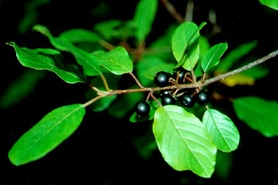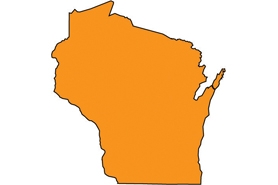Glossy buckthorn
(Frangula alnus)
An understory shrub or small tree grows up to 20' tall, often with several stems from the base and a spreading crown. Gray to brown bark with prominent light-colored lenticels. (Caution: native plums and cherries have a similar bark). Cut bark or branch exposes yellow-orange inner bark.
Other names for this plant include:
- Common names: alder buckthorn, European alder buckthorn, tall hedge buckthorn, columnar buckthorn
- Scientific names: Rhamnus frangula
Classification in Wisconsin: Restricted. This includes all cultivars except 'Asplenifolia' and 'Fineline'/' and Ron Williams.'
- Ecological Threat
-
- Invades wetlands including acidic bogs, calcareous fens and sedge meadows. It also grows well in various upland habitats and tolerates full sun to deep shade.
- It can form dense, even-aged thickets, reducing light availability for understory species and preventing native tree regeneration.
- Identification
-
Leaves & stems: Ovate or elliptic, with prominent veins that come straight out from the midrib and curve slightly towards the tip. Mostly alternate leaves, 2-3" long, with a glossy upper surface and dull underside that may be hairy. Leaf margins are untoothed. Leaves stay green into fall.
Flowers: Inconspicuous, small, and clustered in leaf axils. Pale-yellow, 5-petaled flowers bloom from mid-spring to the first frost.
Fruits & seeds: Abundant clusters of round, pea-sized fruit. Fruit ripens progressively from red to dark purple in late summer. Birds and mammals disperse them. Fruits can remain on plants after all leaves have fallen.
Roots: Extensive fibrous root system.
Similar species: Alder buckthorn (Rhamnus alnifolia; native) is less than 3' tall with thornless twigs. Lance-leafed buckthorn (R. lanceolata; native) is less than 6' tall, found in wet areas and on dry limestone slopes, and has alternate leaves, 2-6" long, gradually tapering to a point at the tip. Carolina buckthorn (R. caroliniana; native), found in the southern midwest, is 10-30' tall with toothed, mostly alternate leaves, 2-3" long.
- Control
-
Mechanical: Prescribed fire kills seedlings. Small plants may be hand-pulled. Larger plants can be dug or pulled using a leverage tool such as a weed wrench. Effective girdling of trees requires stripping the bark to expose the hardwood at a minimum length of six to ten inches. This may need to be repeated. Restoration of flooding or high water tables in areas where water tables were artificially lowered may eliminate glossy buckthorn.
Chemical: Cut-stump treatment with glyphosate in late fall; cut-stump or basal bark spray treatment around the stem with triclopyr ester in late fall through the winter.
For more information on control techniques, visit the Glossy buckthorn factsheet [exit DNR] by the University of Wisconsin-Extension.
- Resources
- Sources for content:
- Czarapata, Elizabeth; Invasive Plants of the Upper Midwest: an illustrated guide to their identification and control. The University of Wisconsin Press. 2005. Pg. 35-41
- Pennsylvania Department of Conservation and Natural Resources. Species Management and Control Information [exit DNR].


